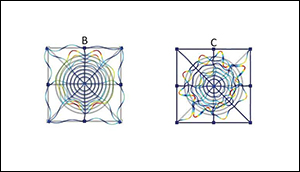Sound-proof metamaterial inspired by spider webs
12. 9. 2016 | Phys.org | www.phys.org
A team of researchers from Italy, France and the UK has designed an acoustic metamaterial (which is a material made of periodically repeating structures) influenced by the intricate spider web architecture of the golden silk orb-weaver, also called the Nephila spider.
By modeling different versions of the new spider-web-inspired acoustic metamaterial, the researchers demonstrated that the new design is more efficient at inhibiting low-frequency sound and is more easily tuned to different frequencies than other sound-controlling materials. Combined with the stiffening mechanical properties and the heterogeneity of spider silk, the tunable acoustic properties demonstrated here suggest that spider-web-inspired metamaterials could lead to a new class of applications for controlling vibrations. Possibilities include earthquake protection for suspended bridges and buildings, noise reduction, sub-wavelength imaging, and acoustic cloaking.

The metamaterial is highly tunable because its geometry is defined by five parameters—which is more than traditional acoustic materials—and each of these parameters can be independently controlled to produce a vast number of designs that respond to different acoustic frequencies. The frequency range that is inhibited by these materials is called the band gap, and here the researchers showed that spider-web-inspired acoustic metamaterials can have wide band gaps, with large ranges of tunability.
Read more at Phys.org
Image Credit: M. Miniaci
-jk-




